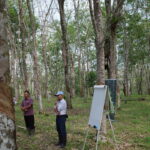As the urgency of tackling climate change becomes more and more evident – June & July 2023 have successively been the hottest months ever recorded in history -, the need for corporates to embark on an energy transition becomes greater. Indeed, while governments try to incentivize and push consumers to change their behavior, the potential of impact largely lies at the level of corporates. As showcased by a report from the Carbon Disclosure Project, 70% of the world’s emissions can be traced back to only 100 companies! Building upon this observation, some initiatives like the Net Zero Asset Owner Alliance or the Net Zero Business Alliance have been established to push companies towards carbon neutrality.
When considering the question of carbon neutrality, most efforts are focused on leveraging carbon-neutral renewable energies to achieve the goals, in a context of increased political and social pressure. However, transitioning to renewable energies is not enough to achieve the targets set at a global level. Indeed, all economic players have to accompany their energy transition with energy sobriety efforts to meet the objectives. This strategy is embodied by the “avoid, reduce, renew” principles adopted by many corporates: energy sobriety, efficiency and renewable energy must go hand in hand.
Nevertheless, energy efficiency & sobriety strategies are overall well-known and mastered today, whereas renewable energy still poses a lot of questions. In fact, while climate considerations often invite corporates to explore biomass alternatives to fossil fuels – biofuels, biogas for example -, little is known of the actual operating models and induced impacts of those solutions.
At the same time, new sustainability tools have emerged over the past decades, such as the Life Cycle Analysis (LCA) which allow to precisely map and measure the overall environmental impact of supply chains.
In that sense, this blog article will explore how LCAs can help corporates compare the relative environmental gains permitted by biomass alternatives to fossil fuels.
Utilizing Agriculture Biomass as a Renewable Energy Source
Growing demand for biomass in energy mix
Currently, there is growing interest in using agricultural products to prepare biodiesel, as they produce fewer emissions and are more renewable than traditional diesel fuel. In Sweden, Denmark and Poland, renewable energies meet over 50% of energy demand. In these countries, the increase in demand for renewable energy is mainly due to the high acceptance of biomass for the production of biofuels for transport and power generation. It is estimated that the biomass-based energy option will account for more than 50% of net energy demand in most developed countries by 2050. Agricultural biomass could be used for biofuel production, boosting future energy security without compromising food availability.
Sources and consumption of biomass worldwide
Indeed, agricultural biomass is produced in large quantities around the world, including corn straw, wheat straw, rice straw and sugarcane bagasse. While Asia produces the largest amount of wheat and rice straw, the United States is the main producer of corn straw and sugarcane. Each type of agricultural waste has a different composition which influences its energy content.
Moreover, Agricultural biomass is more popular in developing countries as it is cheap and easy to access. However, consumption varies greatly between regions: 47% of total biomass energy is consumed in Asia and 1% in Oceania. Even though agricultural biomass is less energy intense than fossil alternatives, it has been widely used in Asia & Africa. However, wood still remains the largest energy source for heating and cooking in those areas.
Different uses for agricultural biomass
Finally, agricultural biomass can be used as an energy source in various forms, depending on its properties and availability. The most common uses are:
- Directly combustible fuel: any processed or raw agricultural biomass can be used for heating, cooking, and lighting.
- Gaseous fuel: agricultural biomass serves as the basis for producing bio-gas or bio-methane through a gasification process.
- Liquid fuel: one of the most widely used forms of biomass is bio-fuel, produced from agricultural biomass by transforming cellulose content of biomass into bio-ethanol.
- Fuel pellets: biomass for tree plantations, such as leaves bark…, can be used to produce wood pellets that can be exploited for cooking in domestic purposes or in industrial boilers for thermal energy for example.
- Electric power generation: agricultural biomass can also be used to produce electricity in power plants.
Today, most of agricultural biomass is used for heating purposes (around 70%), then bio-fuels (16%) and electricity (15%).
Agricultural biomass presents a lot of benefits for the energy transition. However, issues such as environmental damages, and competing uses of agriculture biomass must be considered and weighted to be able to compare alternatives. In that sense, the Life Cycle Analysis tool offers a good protocol to measure the complete environmental footprint of fuels.
Using LCA to measure environmental footprint
Life Cycle Analysis
Life cycle analysis (LCA) is a method of evaluating the environmental impacts associated with all stages in the life cycle of a product, process, or commercial service. For example, in the case of a manufactured product, environmental impacts are assessed from the extraction and processing of raw materials (cradle), through the manufacture, distribution and use of the product, to the recycling or final disposal of the materials that make it up (grave).
An LCA study involves a complete inventory of the energy and materials required throughout the industrial value chain of the product, process, or service, and calculates the corresponding emissions into the environment. LCA therefore assesses potential cumulative environmental impacts. The aim is to document and improve the product’s overall environmental profile.
Taking the example of biomass energy, an LCA would detail the whole supply chain from the establishment of the plantation, planting of the seeds, to the combustion of the biomass or conversion into energy. At each step of the process, it inventories the inputs and outputs of each process to measure the global environmental footprint of the product.
Today, software like openLCA or SimaPro, combined with databases such as Ecoinvent allow to perform LCA studies on a wide range of products with data gathered around the world. Of course, field-collected data provides the best quality and robustness for LCA studies.
EU’s product environmental footprint methodology
While LCA has been around for some time, many different methodologies have coexisted. Some references are ISO 14040, or the International Reference Life Cycle Data System (ILCD). While most methodologies follow the same general process, variations in the calculation methodologies and treatment of certain manufacturing processes can lead to different results. As the main goal of LCA’s is to compare alternatives, homogeneity of methodology is critical.
In this respect, the European Union has developed its own methodology – the Product Environmental Footprint – to conduct LCA studies. The PEF is based on the scientific method for measuring environmental footprints (LCA) and outlines an improved common framework for all the steps & rules necessary to perform LCA studies. It is however still in a transition phase and not mandatory yet.
As the PEF provides a single and more stringent method used by everyone in the market, its ultimate goal is to improve validity and comparability between products on the EU market. Its mission is to strengthen the EU market for green alternatives and tackle greenwashing and false sustainability claims.
Another interesting aspect of the PEF methodology is that it adopts a holistic approach and considers a wide range of issues outside of just climate change. In that sense, the PEF methodology considers 16 impact categories which cover a broad range of relevant environmental issues related to the product supply chain of interest, from climate change to land use change or water use.
Ksapa has been conducting LCA studies on issues related to energy transition and agricultural biomass. Combining its expertise and knowledge on LCA, sustainable agriculture, fragmented supply chains, and human rights, Ksapa has derived a number of learnings from its studies.
Lessons learned from Ksapa’s LCA studies
LCA robustness and Data collection
As mentioned above, LCA defines the different steps of the supply chain and inventories the inputs & outputs in terms of resources and energy for each of the processes. In this respect, an LCA study is heavily reliant on data collection. In fact, the PEF methodology defines the Data Needs Matrix which details the required level of quality & granularity of data to be collected depending on the level of control of each process with respect to the LCA study’s principal.
While most products can be modelled using generic databases, in order to provide LCA studies as valid as possible it is critical to collect data directly from the field. Indeed, LCA relies upon many processes with different interactions and interdependencies which might differ from case to case. Conducting an LCA study which relies upon too many hypotheses generates the risk of producing a result that is not representative and that cannot be used in decision-making.
This is particularly true for agricultural biomass. Conducting an LCA on agricultural supply chains is often more complex as the value chains can be quite fragmented with practices varying a lot from one territory to another. Conducting field studies is critical to the validity of the LCA in a specific context.
LCA’s holistic approach
LCA studies provide interesting results on several aspects of a solution.
First, it gives a snapshot of a solution’s impact on different categories. These impact categories allow to broaden the scope of risks to be taken into account when making a decision about energy transition solutions. Indeed, while most would make decisions based on a solution’s contribution to climate change, it is important to consider other aspects such as land use, water or resources use to make an informed decision.
Second, an LCA study provides insights into the supply chain and helps identify the hotspots. By analyzing the contribution of each process to the different impact categories, we can identify the most contributive processes: hotspots. This is particularly interesting for solutions relying on agricultural biomass as supply chains can be complex. This way the LCA does not only provide a result to the decision-maker, but also a list of processes & practices to improve or monitor in order to continuously improve the end-product’s footprint. It gives a roadmap for improvement.
Adopting a just transition approach
As mentioned above, LCAs give the opportunity to broaden the scope of environmental issues studied and expand beyond climate-only considerations. In the same way, it is critical to integrate other analytical lenses to provide a complete picture of the ESG profile of a product. Indeed, when considering agricultural value chains, environmental issues should not be the sole concern. Most of these value chains actually involve significant human rights risks like child labor, forced labor, decent living income… As such, a decision-maker should complement the LCA with an analysis of the human rights & social risks posed by the product’s supply chain to make sure all risks are covered. Indeed, a human rights study would not only allow to account for external stakeholders’ grievances and priorities, but most importantly to focus the debate on a “just transition” and not just an energy transition.
Expanding from supply chains to agricultural territory
When looking at the production of biofuels from agricultural waste, the equation seems simple: the more waste is collected, the more fuel is produced. Building upon this simple analysis, many biofuel supply chains have been established: sugarcane or colza plantations covering miles and miles only dedicated to biofuel. However, this approach lacks vision. Not only does it sideline the question of crop diversity, which also impacts biodiversity in its entirety, but it also fails to examine the entirety of the local agriculture sector: not only focusing on sugarcane supply chain, but also its relations with other agricultural commodities either for cash or for food. This lack of vision can have consequences when trying to set up a new supply chain dedicated to biomass energy. Converting most food crops to cash crops inevitably fosters food insecurity.
As such, it is imperative for all decision-makers, whether at the corporate or local authority level, to look at agriculture in its globality, and its footprint on the territory. A great tool for that is satellite imagery. By using imagery produced by NASA or Copernicus program satellites, it is easy to get an idea of the land use in territory and its evolution over time. Those analyses greatly complement LCA studies, as it gives a concrete image of the reality on the ground: it translates risks into reality, and help to understand the drivers of deforestation, urbanization, water scarcity… This way, agricultural biomass supply chains can be established in a sustainable manner, keeping in mind its footprint on the local basin, and its impact on other food or cash crops.
Conclusion
Agriculture biomass presents a great opportunity to turn waste into a renewable, accessible, and affordable source of energy. However, many environmental and social issues inherent to those fragmented supply chains must be considered when comparing alternatives to fossil fuels.
LCA studies allow robust assessments of products’ environmental footprint, detailing the different impacts and hotspots on a supply chain. Nevertheless, LCA must not be the sole decision-making tool when tackling energy transition strategies. Indeed, it must be complemented by human rights analysis & value chain approaches to expand its scope and allow for a decision with a just transition in mind and not just an energy one.
Adrien is a SUTTI Program Officer. He’s responsible for the development, operational implementation, and monitoring of SUTTI programs. He participates in designing financial structuring schemes leveraging SUTTI’s impacts.
He has previous experiences in various industries, within public, private, and non-profit organizations. Before joining, he was involved in microfinance and social entrepreneurship initiatives in Cambodia and the Philippines, after working for Danone and RATP.
He holds a Master’s in Finance from Paris-Dauphine University, as well as a Master in Management from ESSEC Business School.
He speaks French, English, and Spanish.













